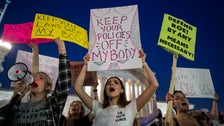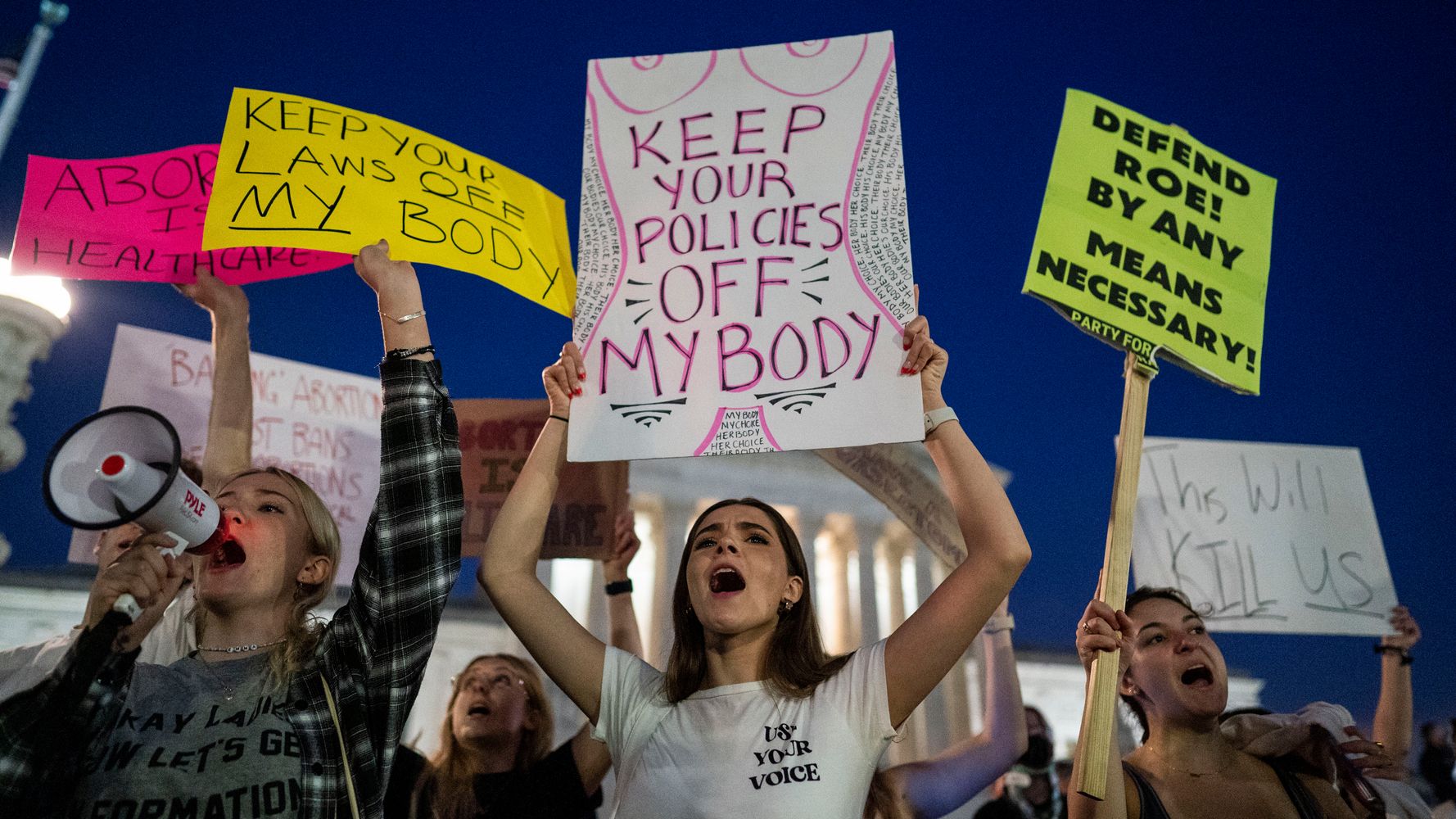[ad_1]

The right to protest is enshrined in the U.S. Constitution. In recent years, more and more people seem to be rising up ― both in this country and abroad, where protesting can be more perilous.
A recent study examining demonstrations between 2006 and 2020 reported that the number of protest movements worldwide had more than tripled in that time. A leaked Supreme Court draft opinion striking down Roe v. Wade, taking away the right to abortion established a half-century ago, suggests a coming court ruling likely to further stir Americans into the streets.
But with the rise in protests has also come an increase in incidents of police brutality, use of chemical weapons, mass arrests, violent clashes with counterprotesters, and other dangerous situations.
That doesn’t mean the act of protesting is inherently unsafe, however. There are precautions people should take when they go out and demonstrate. Below, we share some expert-backed advice.
Know your rights
“The First Amendment protects our right to make our voices heard, including by gathering together in public and protesting,” said Vera Eidelman, staff attorney with the ACLU Speech, Privacy and Technology Project. “The restrictions that government actors can place on public protest are limited, but the fact is that they don’t always stick to the rules. It’s a good idea to make sure you’re prepared by brushing up on your rights before heading out into the streets.”
Eidelman highlighted some key rights that are important to know before you participate in a demonstration. (The ACLU website’s “Know Your Protest Rights” page offers more details.)
“You don’t need a permit to protest in response to breaking news,” Eidelman said. “You also don’t need a permit to march in the streets or along sidewalks, as long as you’re not obstructing car or pedestrian traffic, or access to buildings. If you don’t have a permit, police officers can order you to move to the side of the street or sidewalk to let others pass or for safety reasons.”
If you are lawfully present in a public space, you have the right to photograph anything in plain view, which includes federal buildings and any police present. If you believe your rights were violated during a protest, take a moment to get contact information from witnesses, photograph any injuries and write down all the details you can remember.
Eidelman noted that the main job of the police during a protest should be to protect your right to protest and de-escalate any threat of violence.
“If you get stopped by police, ask if you’re free to go,” Eidelman advised. “If they say yes, calmly walk away. If you get arrested, you have a right to ask why. Otherwise, say you wish to remain silent and ask for a lawyer immediately. Don’t sign, say or agree to anything without a lawyer present.”
Dress for safety
“Even though we’re going into a hot season, you should still be doing a long sleeve so your body is covered as much as possible for protection from both the sun and tear gas,” Ernest Coverson, campaign manager for Amnesty International’s End Gun Violence, previously told HuffPost. “You want long pants, comfortable shoes ― something with a tie-up versus a slip-in ― and nothing loose that can get snagged on things, yanked or pulled.”
Coverson recommended against applying any oils or lotions, as they can “intensify the lingering effect” of agents like pepper spray or tear gas, which can cause skin rashes and burns, tearing and burning eyes, blurred vision, chest tightness, nose swelling and other irritations.
In addition to comfortable shoes and clothes that cover your skin, Amnesty International advises wearing a bandana soaked in water, lemon juice or vinegar to cover your nose and mouth, which can aid in breathing during chemical exposure. Bring a plastic bag with a change of clothes in case of contamination, and wear glasses instead of contact lenses.
“If you get gassed or maced in contacts, the irritant can get trapped underneath and can mess up the lens itself,” Coverson said. “If you’re able to bring goggles (swim goggles are fine), that would also offer added security.”
Tie your hair back and wear a face mask or face shield, which can offer protection from COVID as well as other potentially harmful exposures. Cover identifying features like tattoos and try to wear generally nondescript clothing. And of course, check the weather forecast.
Be mindful of what you bring
When packing your bag before a protest, keep health and safety in mind. Make sure you eat and hydrate at home, and bring extra snacks and water to drink. A water bottle with a squirt top is also useful to wash your skin and eyes if you’re exposed to tear gas or other chemicals.
Bring cash and coins, carry a form of identification and write your emergency contact information on your arm or elsewhere on your body. Medication and first aid supplies are also helpful.
If you decide to bring your cellphone, disable the face or touch ID modes so that no one can force you to unlock it without your consent. Experts also advise backing up your data beforehand and turning on Airplane Mode.
Before you go to a demonstration, research the event to see if the organizers have issued any advice regarding things to wear and bring, and other expectations. Take time to look into the organizers of the protest as well, to ensure the movement aligns with your values and doesn’t promote violence or any other issues that could harm your health and safety.
Don’t go to a protest alone, if possible. Try to buddy up with someone, meet up with an affinity group or at least let your loved ones know where you’ll be in case something happens.
And don’t forget to make a sign with the message you’d like to share in the protest.
Stay vigilant
From violent attacks from counter-protesters to instances of police brutality, there are many ways for demonstrations that start out peaceful to become unsafe.
As you participate in a protest, be vigilant. Pay attention to the people around you and what they’re doing. If someone is exhibiting distress or panic, try to calm them or help them find safety.
Locate the nearest exits in case you or your peers need to quickly leave the demonstration. Take note of any cars with drivers nearby.
Resist the temptation to engage with counter-protesters, who often shout and hold signs with inflammatory messages with the goal of creating conflict. Don’t indulge them.
Try to remain calm and focused, and pay attention to any instructions or requests from the protest leaders.
Be prepared to deal with tear gas or pepper spray
Police have been known to deploy pepper spray and tear gas against demonstrators. Although they are chemically different agents, both have irritating effects.
In addition to the previously mentioned preparations, you can learn what to do if you’re exposed to an irritant like this.
The best way to deal with pepper spray or tear gas is to flush it out of your eyes with water and remove yourself from the area. Blink rapidly and resist the urge to touch or rub your eyes.
Squirt your water bottle into your eyes (being mindful not to transfer more chemicals from the surrounding skin into your eyes) as soon as you can, but then try to get to a sink or shower for more thorough rinsing.
We “run liters of water, potentially, into [a patient’s] eyes until they are feeling better and we feel like the chemical is out,” Dr. Diane Calello, executive and medical director of the New Jersey Poison Center, previously told HuffPost.
Although many people suggest using milk to rinse out your eyes, doctors don’t typically recommend it.
“Will it hurt to pour milk into your eyes instead of water? No, it won’t, but it probably does not have any benefit over water or saline irrigation,” Calello said.
In addition to cleaning your eyes, try to cough, spit and blow your nose to get as much of the chemical out of your body as possible. And if the burning and itching persists for several hours ― even after you’ve showered, changed and otherwise decontaminated yourself — consider seeking medical attention.
Coming into contact with tear gas or pepper spray can be painful and traumatic, so once you’re finished washing it out and otherwise tending to your physical health, take some time for other forms of self-care as you process and recover from the experience.
[ad_2]
Source


